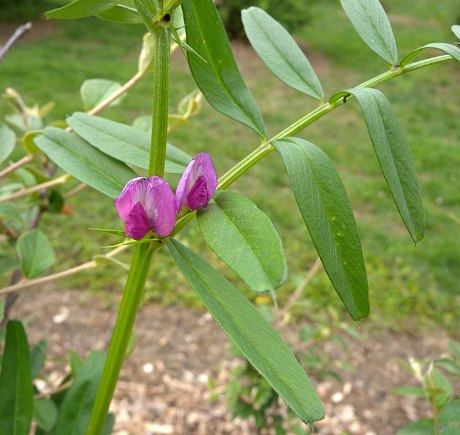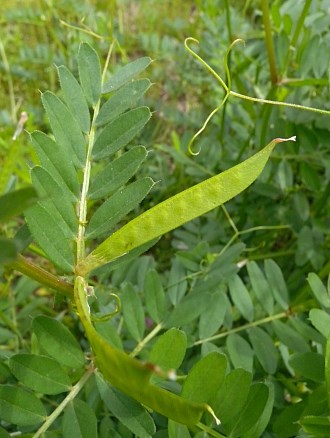
The middle to upper leaves produce 1-2 flowers from their axils; these flowers are nearly sessile (pedicels about 1 mm. long). Individual flowers are about ¾" long, consisting of 5 purple petals and a light green tubular calyx with 5 teeth. The petals are arranged in a pea-like floral structure consisting of a banner, 2 wings, and a keel; the latter encloses the reproductive organs. There is usually a patch of white at the base of the banner (uppermost petal). The teeth of the calyx are linear-lanceolate and similar to each other in length. The blooming period occurs from late spring to mid-summer for about 2 months. The flowers are replaced by elongated seedpods about 1½-3" in length that are hairless. Initially, the seedpods are green and flattened, but they later become dark brown and more swollen as the seeds enlarge. Each seedpod contains 5-12 seeds. Individual seeds are subgloboid (somewhat flattened) and smooth. This wildflower spreads by reseeding itself.
Cultivation: Common Vetch adapts to full or partial sun, moist to dry-mesic conditions, and a variety of soil types, including those that contain loam and clay-loam. The root system can nodulate and add nitrogen to the soil. Most growth and development occurs during the cool weather of spring. Because this wildflower can reseed itself aggressively, it is rather weedy.
 Range
& Habitat: The
non-native Common Vetch is occasional in both northern and southern
Illinois, while in the central part of the state it is largely absent
(see Distribution
Map).
However, it is likely to spread to all areas of
the state in the future. The distribution map combines information for
both Vicia sativa sativa
and Vicia sativa nigra.
Common Vetch was
introduced into North America from Eurasia for agricultural purposes.
Habitats consist of cropland (mainly wheat fields), fallow fields,
weedy meadows, roadsides, areas along railroads, and miscellaneous
waste areas. Sometimes Common Vetch is deliberated planted as a source
of forage for farm animals. Habitats with a history of disturbance are
strongly preferred.
Range
& Habitat: The
non-native Common Vetch is occasional in both northern and southern
Illinois, while in the central part of the state it is largely absent
(see Distribution
Map).
However, it is likely to spread to all areas of
the state in the future. The distribution map combines information for
both Vicia sativa sativa
and Vicia sativa nigra.
Common Vetch was
introduced into North America from Eurasia for agricultural purposes.
Habitats consist of cropland (mainly wheat fields), fallow fields,
weedy meadows, roadsides, areas along railroads, and miscellaneous
waste areas. Sometimes Common Vetch is deliberated planted as a source
of forage for farm animals. Habitats with a history of disturbance are
strongly preferred.Faunal Associations: The flowers are cross-pollinated by bumblebees and other long-tongued bees. Various insects feed destructively on the foliage, flowers, or developing seedpods of Vicia spp. (Vetches). These species include the caterpillars of such butterflies as Colias eurytheme (Orange Sulfur), Colias philodice (Clouded Sulfur), Everes comyntas (Eastern Tailed Blue), Glaucopsyche lygdamus couperi (Silvery Blue), Leptotes marina (Marine Blue), and Strymon melinus (Gray Hairstreak). It also includes caterpillars of the skipper, Erynnis funeralis (Funereal Duskywing), and the moth, Caenurgina chloropha (Vetch Looper). Vetches are food plants of Acyrthosiphon pisum (Pea Aphid), several leafhoppers (Empoasca spp.), and the thrips, Sericothrips cingulatus. The foliage of Common Vetch is edible to mammalian herbivores: It is readily eaten by cattle, horses, sheep, deer, rabbits, and groundhogs. Even though the seeds are potentially toxic, they are sometimes eaten by such upland gamebirds as the Ruffed Grouse, Wild Turkey, Greater Prairie Chicken, and Bobwhite; some of these birds also consume limited amounts of the foliage.
Photographic Location: Along a railroad and at The Arboretum of the University of Illinois in Urbana, Illinois.
Comments: Common Vetch is less showy than other vetches because its flowers are more likely to be hidden within the foliage. Unlike many other vetches, Common Vetch produces its flowers in sessile pairs or individually, rather than in one-sided racemes of 3 or more flowers. Several varieties or subspecies of Common Vetch have been described in Europe, although they are not distinguished here. Mohlenbrock (2002) refers to the narrow-leaved subspecies of Common Vetch as Vicia angustifolia, which is a scientific synonym of Vicia sativa nigra.